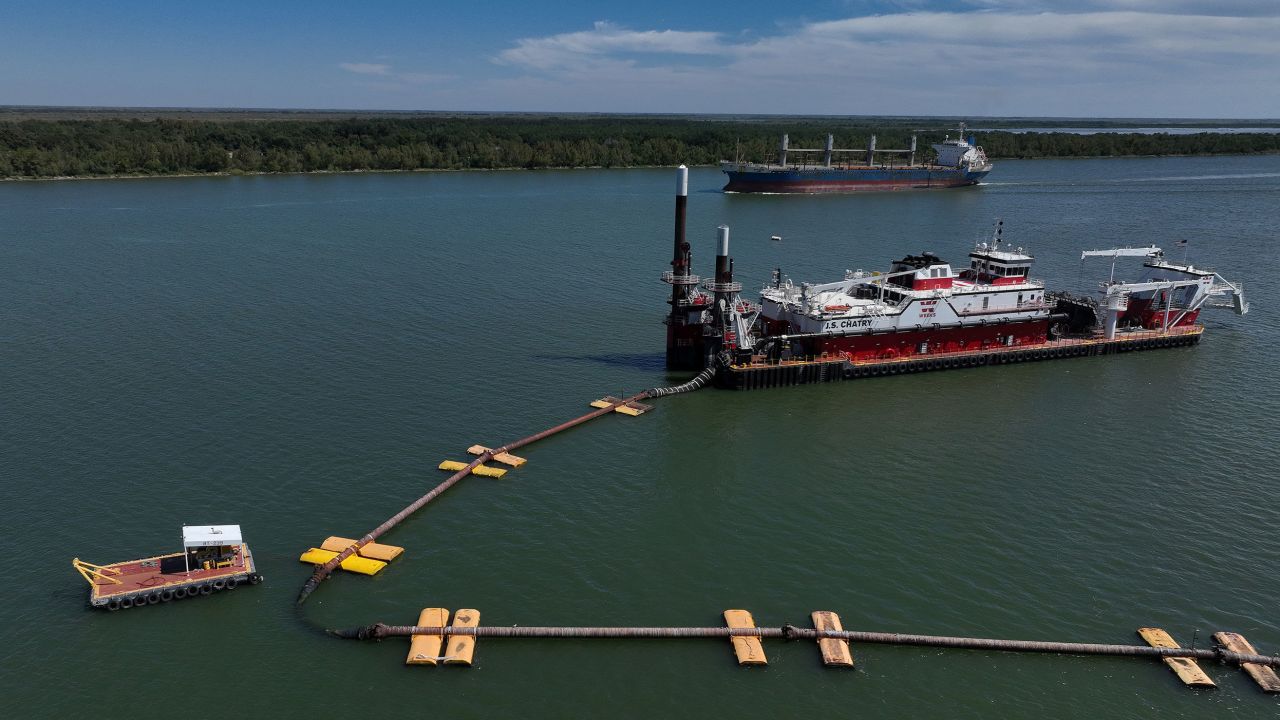CNN
—
It would be a nightmare for any city: A massive wedge of saltwater creeping up the Mississippi River, contaminating drinking water at treatment plants one-by-one and threatening the health of hundreds of thousands of residents.
But it’s a looming catastrophe for New Orleans, where officials estimate that tens of thousands of the city’s water pipes are made of lead.
New Orleans is far from the only city in the US with lead pipes, but over the last few weeks it faced the possibility that, without a herculean and costly effort to stop it, saltwater could corrode those pipes and leach toxic metals into the drinking water supply.
The effort to prevent this is unfolding at emergency pace, even as the outlook has improved, with the Army Corps of Engineers predicting saltwater will not reach New Orleans.
But this threat is not a one-off: Experts say the region needs to solve the problem now, as climate-fueled drought on the mighty Mississippi continues to collide with the aging infrastructure winding below the city streets.
There is no safe level of lead exposure and even small amounts can be harmful, the US Centers for Disease Control has said.
Lead is especially harmful for babies and young children, with exposure to the metal linked to brain and nervous system damage, learning disabilities, and physical impacts including increased risk of heart and kidney disease. And it can take years for the full impacts of lead exposure in a child to become known.
Complicating matters in New Orleans is the fact that city officials don’t know how exactly how many pipes are made of lead and where those pipes are.
“New Orleans is an important reminder to lots of other (coastal) cities in the South that you might not be thinking of the degree to which lead pipes are a problem – but they are,” Eric Schwartz, a professor at University of Michigan’s school of business and co-founder of BlueConduit, a water analytics company helping cities, including New Orleans, map their lead pipes, told CNN.
Many residents aren’t even aware they have lead pipes supplying their drinking water, said Jessica Dandridge, executive director of the Water Collaborative of Greater New Orleans. Dandridge’s organization works both on water quality issues around the city’s lead pipes and stormwater management and flood control, and they are one of BlueConduit’s local partners working to map the pipes.
The saltwater wedge has made people aware for the first time, she said: “They know their health is on the line.”
A lot is at stake for New Orleans and other cities racing to comply with new federal rules that aim to get lead pipes out of the nation’s drinking water system, plus a total of $15 billion in new federal money in the bipartisan infrastructure law to start removing the dangerous element from dozens of city drinking water systems.
Lead “was so popular because it was so useful,” Danielle Land, a public health research associate and lead pipe expert at Michigan State University, told CNN. “We put it in everything, and now we don’t have the money to remove it from everything.”
Lead was ubiquitous in water infrastructure for decades because it was malleable, plentiful, and less prone to corrosion than other metals. There was a big uptick in its use at the start of the 20th century, as well as during the 1940s and 1950s during a boom in housing construction.
As a result, lead drinking pipes are all over the country; some national estimates say the total number of pipes is around 9.2 million.
“The younger you are exposed to lead, the worse,” Land said. “If we give a very young baby formula with tap water that has lead in it, their body is less able to fight off and resist the effects of lead.”

Other risk factors that make things worse include length of exposure and how high the lead level is. But there are things families can do to guard against lead exposure in their kids; for instance, good nutrition and ensuring children are getting enough calcium, iron and vitamin C is paramount, Land said.
Dandridge said her organization is keeping an eye out for lead poisonings in New Orleans, especially because most residents don’t know if they have lead lines.
The danger doesn’t just come from saltwater, it’s also elevated during street construction – a frequent occurrence in the years since Hurricane Katrina, according to Dandridge. But as crews fix roads, they can also disturb corrosion control measures put in place by the city’s Sewerage and Water Board.
“There are several people we know who have lead poisoning,” Dandridge said. “Once you have lead poisoning, that is your life.”
New Orleans and other cities are racing to map their lead pipes as the Biden administration has made billions of dollars available to states and cities to remove the dangerous infrastructure.
In New Orleans, that work is a painstaking mix of water testing and digging through old records.
It’s “almost a sleuthing or detective (work), trying to find out where the pipes are and where they go,” New Orleans City Councilmember JP Morrell told CNN. “We have transitioned as far as our large, major infrastructure, but it’s not widespread; we’re not there yet.”
The 305-year-old city has mapped the age of its water pipes, and the vast majority were laid between 1900 and 1919 – an era when lead was frequently used. Other pipes are made of clay or iron but may have lead soldering between the joints.
“Record-keeping when they started laying down lead pipes in the 1800s was abysmal, and most of the later records were kept on note cards,” said Adrienne Katner, a professor of environmental and occupational health at Louisiana State University Health Sciences Center New Orleans.

Piecing records together is a mix of filling the gaps in the system and trying to decipher everything from handwritten notes to typewritten notes that are missing what material a pipe is made from. BlueConduit researchers have been using AI to sort through records for months.
“We have seen some records from New Orleans that are over 100 years old; we were looking at a scan of an index card earlier today,” Schwartz, BlueConduit’s co-founder, told CNN. “There’s typewritten things. There’s pencil, there’s pen, and to take this information in and make sense of is already a challenge.”
Grace Birch, a spokesperson for the city’s Sewerage & Water Board said the “painstaking” inventory should be completed by October of next year – a federal deadline to submit digital mapping of the city’s lead pipes.
But even if the city is able to eradicate every lead pipe from its water mains, there is also the issue of replacing smaller pipes on private property going into homes, which could present an even more complex and costly challenge.
Land said it will likely take decades to make good on the Biden administration’s goal of eradicating lead pipes from America’s drinking water infrastructure, but the federal funding is a step in the right direction.
“It’s promising, it’s a step in the right direction that we can get all our policymakers and all our government folks behind the same goal,” Land said. “It’s not enough, but it’s a start.”
Even though New Orleans is one of many cities around the national dealing with lead pipes, the saltwater creeping up the Mississippi river is an example of how climate change is colliding with America’s aging infrastructure, said Jeffrey Thomas, a New Orleans-based attorney who previously led a city task force on addressing vulnerabilities in the city’s water system.
“It’s an example of how climate change can exacerbate pre-existing physical, social, and economic vulnerabilities in any city; particularly ones already susceptible to extreme weather conditions such as New Orleans,” Thomas said.
Dandridge, the New Orleans community organizer, told CNN she often encounters apathy from the city’s residents who don’t believe the government will fix the problem quickly enough – or at all.
“There’s always a crisis and people in Louisiana are exhausted, but we’re also stuck in a rock and a hard place,” Dandridge said. “It’s hard enough with climate change, it’s even harder when the government is not necessarily thinking proactively of its citizens.”